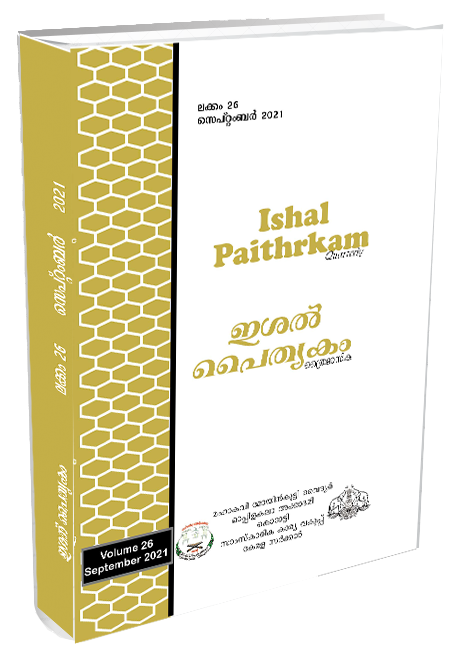Visual analysis of ritualistic art form of Kerala: Sarpam Kalemezhuthu (snake floor writing/design)
Keywords:
Art, Form, Media, Iconography, Image, Sarpa kalam, Visual design, Ritual, WritingAbstract
Snake worship is a revered practice in the Hindu religion; it takes deep cultural and ritualistic roots in several places in Asia. Snake worship, as a practice, is reinforced with found sacred snake groves, statues made out of stone and, other ritualistic practices such as sarpam kalemezhuthu-pattu/thullal (snake floor writing, songs and dance). It is iconographic and predominantly found in the state of Kerala, India. Sarpam kalemezhuthu-pattu/thullal amalgamates forms of dance, music and, visual art into a single ritual. Sarpa kalam (snake floor writing/design) is the artistic segment of the ritual. This paper seeks to study the visual characteristics of sarpa kalam and attempt to analyze form and the meanings it may derive.
Downloads
References
A.R., A. ( 2018, April 20 ). Special Features, Deities and Rituals associated with Sacred Groves. Retrieved May 2021.
Achari, P. S. (2015). Hindu Iconography. Simha Publications .
Achari, P. S. (2015). Simha Publications . Retrieved 4 2021.
Ambily C.S.1, A. K. (2015). Iconography of the Recently Discovered Naga Sculptures from Pamba River Basin, Pathanamthitta District, South Kerala . Journal of Multidisciplinary Studies in Archaeology, 17.
Arora, R. K. (1983). Snake worship in ancient India.
B, D. (2020, August 20). Sarppakalam and Snake Dance: Kerala’s Age-Old Tradition of Serpent Worship . Retrieved Feb 2021.
Borah, S. (2017). Ancient worships in India. International journal of Media Studies, 8.
Borah, S. (2017). ‘Nagas’: The Religious Pantheon of Ancient India. International J. Advances in Social Sciences , 4.
Dinu Das1, a. A. (2017). The Practice of Traditional Rituals in Naga Aradhana (Snake worship): A Case study on Aadimoolam Vetticode Sree Nagarajaswami Temple in Kerala, India. SHS Web of Conferences, 7.
Express, T. n. (2012 , August 27). ‘Pulluvan Paattu' fading into oblivion due to lack of patronage. Retrieved Feb 2021.
G, D. (2018). The ‘Sarpa Kavu’ or ‘Sacred Groves’ of Kerala: An objective correlative of nature, IJCRT, 3
Heibutzki, R. (n.d.). The Iconography & Symbolism of the Lascaux Cave Paintings. Retrieved from https://education.seattlepi.com/iconography-symbolism-lascaux-cave-paintings-6924.html
History, N. M. (2011, June 27). Festival of museums and intangible natural heritage. Indigenous graphic design practices. (n.d.). In T. s. design.
Kallungal, D. (2014 , September 23). Sarpam Thullal: A Rustic Dance Form Fading into Oblivion. Retrieved Jan 2021
Kapila, S. ( 2017, May 16). The art of Kalamezhuthu from Kerala. Retrieved April 2021
Lisa, M. (2021, July 29). The Definition of 'Form' in Art. Retrieved from https://www.thoughtco.com/definition-of-form-in-art-182437
Mathrubhumi. (2010, Nov 8). Century-old Hindu ritual makes a comeback in Kerala. Retrieved Jan 2021
Mission, C. (2018). Ashtanaga / Nagayakshi Kalam Pattu -2018 at Adi Sankara Nilayam. Retrieved Feb 2021
Nazariya. ( 2016, December 27). Kalamezhuthu from Kerala: the Rangoli with a difference. Retrieved Feb 2021
Pandey, D. A. (2020). some repesentative folk art of India. international journal of research -Granthaalayah, 9.
Pillai, A. K. (2017). Rituals of Kalicult in Kerala . International Journal of Research , 10.
Powell, J. (1998). Postmodernism. Orient BlackSwan.
Raos, S. (2018, June 9). The Naga worship . Retrieved April 2021.
Saju, S. (n.d.). The Pleasure in Liminality: A Psychoanalytic Re-Reading of Sarpam Thullal. https://www.academia.edu/.
Santhakumar, A. (2018, March 1). Kalamezhuthu Pattu – Ritual Art of Kerala. Retrieved March 2021.
Schleimer, L. (2008). Art in Antiquity. Retrieved from https://www.brown.edu/Departments/Joukowsky_Institute/courses/artinantiquity/7146.html.
Sharma, S. (n.d.). Sarpam Thullal- A Mystical Experience. Retrieved May 2021
Sinu2, F. L. (2019). Sacred groves and serpent-gods moderate human–snake relations. British ecological Society.
Sources of Ancient Indian Iconography. (n.d.). Retrieved Feb 21, 2021.
sudheer. (2017, Sep 15 ). Sudheer Mullurkkara - The storyteller of serpents. Retrieved January 2021.
T. A. Gopinatha RGopinatha rao, m. (1914). Elements of hindu iconography. Madras: the law printing house mount road.ao, m. (1914). Elements of Hindu iconography. Madras: the law printing house mount road.
Tate. (n.d.). Art term, take Modern. Retrieved from https://www.tate.org.uk/art/art-terms/f/form.
Unnikrishnan, E. M. (n.d.). Temple Arts. Retrieved April 2021.
V.S., R. (2008). Socio-cultural perspective to the sacred groves and serpentine worship in Palakkad district, Kerala. Indian Journal of Traditional Knowledge.
Downloads
Published
Issue
Section
License
Copyright (c) 2025 ISHAL PAITHRKAM

This work is licensed under a Creative Commons Attribution-NoDerivatives 4.0 International License.

